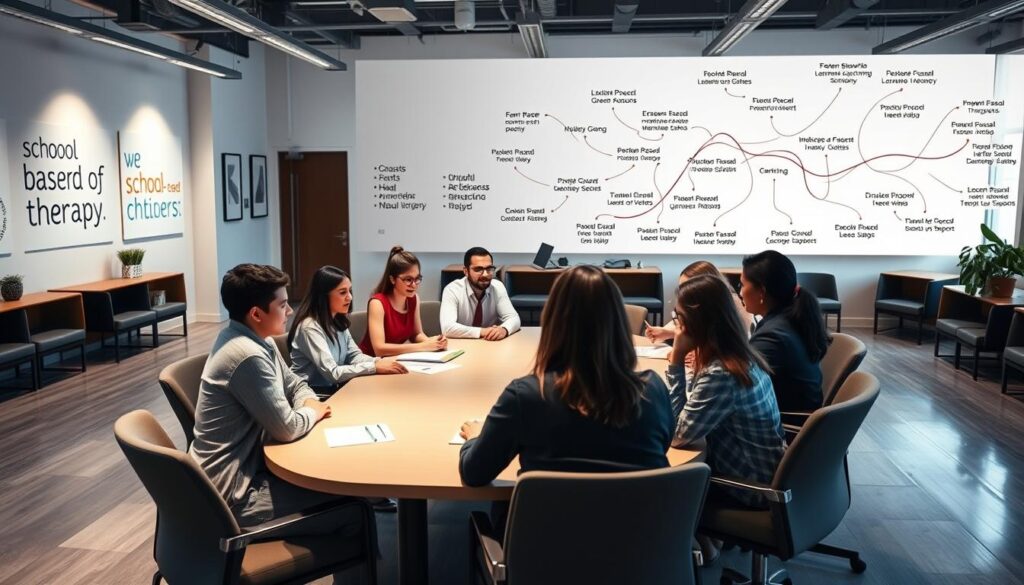School-based therapists are key in helping students do well in school and feel good. As schools focus more on mental health, these professionals need to know how to handle the special challenges of this job. This guide will share effective ways to succeed in school-based therapy, helping you balance your work with the school’s goals.
Therapists in schools must use proven methods in a way that fits the classroom. This article will give you tips on managing your work, working with teachers, and helping students. You’ll learn how to make a bigger difference by being culturally sensitive and using data to guide your work.
Key Takeaways
- Explore strategies to excel in school-based therapy by aligning clinical goals with classroom outcomes.
- Learn how to implement evidence-based interventions within school systems.
- Understand the importance of collaboration with educators and administrators.
- Discover methods to address diverse student needs efficiently.
- Gain tools to advocate for resources and improve therapy outcomes.
The Evolving Role of School-Based Therapists in Educational Settings
School-based therapy is now a key part of education. Therapists help with both learning and emotional issues. This is thanks to laws like the Individuals with Disabilities Education Act (IDEA) and more awareness of mental health.
Now, therapists work together with schools. This focus on teamwork helps students grow in all areas. It’s about more than just fixing problems; it’s about helping students thrive.
Understanding the Modern School Therapy Environment
Today’s schools need therapists who can meet many needs. They must follow rules and focus on students. Key challenges include having enough time and dealing with many students’ needs.
Good therapists use data to track how students are doing. They find ways to meet the school’s goals while helping students.
Bridging Clinical Practice and Educational Objectives
- Align therapy goals with academic benchmarks (e.g., improving focus for classroom success).
- Train teachers to reinforce therapeutic strategies during lessons.
- Use clinician success tips like co-teaching sessions to merge skill-building with curriculum content.
Key Stakeholders in the School-Based Therapy Ecosystem
Successful therapists work with many people. This includes:
- Administrators: For resource allocation and policy alignment.
- Parents: Through regular progress updates and training in support techniques.
- Community partners: Mental health agencies and local nonprofits for extended services.
This teamwork helps students do better and meets school goals.
Essential Qualities and Competencies for Effective School Therapists
Successful school-based therapists excel by mastering key skills. These skills mix clinical knowledge with the school setting. They adapt to changing school needs and use educational therapy techniques that meet academic goals. Let’s look at the important skills for success:
- Adaptability: Adjusting session times to fit school schedules or urgent needs.
- Cultural Competence: Tailoring support to match diverse student backgrounds.
- Collaboration: Working with teachers, administrators, and families for support.
- Time Management: Managing caseloads and meeting IEP deadlines.
| Competency | Example Application |
|---|---|
| Assessment Skills | Evaluating learning disabilities during classroom observations |
| IEP Expertise | Aligning therapy goals with state education standards |
| Policy Knowledge | Applying ADA guidelines in accommodation planning |
Knowing the law, like IDEA regulations, is crucial. Therapists also use educational therapy techniques like data tracking to measure progress. They keep learning through workshops and feedback from peers. These skills are essential for providing lasting support in schools.
Proven Strategies to Excel as a School-Based Therapist and Clinician
Effective school-based therapists excel by focusing on teamwork and being flexible. They build strong relationships with teachers, which is key to success. Here are some school counselor strategies to help you do well:
Establishing Strong Collaborative Relationships with Teachers
- Attend weekly team meetings to align therapy goals with classroom objectives
- Share progress reports via user-friendly digital platforms like ClassDojo or Google Classroom
- Co-create behavior charts and social stories tailored to classroom needs
Developing Culturally Responsive Therapy Approaches
Make therapy sessions relevant by including students’ cultural backgrounds. Use:
| Practice | Example |
|---|---|
| Family engagement | Invite cultural storytelling from students’ heritage |
| Linguistic support | Use bilingual materials for non-native English speakers |
| Community ties | Partner with local cultural organizations for resource sharing |
Implementing Evidence-Based Interventions
- Select interventions with peer-reviewed research backing
- Adapt 30-minute sessions into 15-minute micro-sessions
- Use apps like Headspace for mindfulness exercises
Managing Diverse Caseloads Efficiently
Make your work easier with:
- Prioritization matrices for urgent vs. routine cases
- Standardized checklists for documentation
- Automated reminders for follow-up appointments
“Time spent building teacher relationships reduces 40% of intervention resistance,” says Dr. Elena Martinez, NASW School Therapy Fellow.
Navigating Administrative Challenges in School-Based Practice
Administrative tasks can take a lot of time and energy from school-based therapists. It’s important to make these tasks more efficient. This way, you can keep providing high-quality care without getting overwhelmed.

Documentation Best Practices for School Environments
Start with standard templates for efficient documentation. Use therapist growth hacks like digital checklists for progress notes and IEP updates. Tools like TheraNest or Swish make tracking easier.
Save time with voice-to-text software or collaborative platforms. These tools can help a lot.
Aligning IEPs with Clinical Goals
“IEPs are roadmaps, not roadblocks. Focus on shared outcomes.”
Link IEP milestones to measurable clinical markers. For example, a speech therapist might use articulation goals for both academic and therapeutic progress. Use SMART criteria to ensure goals are aligned.
Advocating for Resources
Get the tools you need by making strategic requests. Show data on student outcomes to prove the need. Here are some school-based therapy resources to help:
| Resource Type | Description | Example |
|---|---|---|
| Template Libraries | Pre-built forms for IEP alignment | National Association of School Psychologists (NASP) templates |
| Funding Guides | Grants and district budgeting strategies | OSEP’s Therapy Funding Handbook |
Use these resources in meetings with administrators to strengthen your case. Show the return on investment of the materials you request.
Advanced Therapeutic Techniques for the Educational Context
Effective educational therapy techniques need to fit into the classroom. Therapists use methods that work well in groups. They aim to meet both learning and therapy goals. Let’s look at ways to make a big impact without overloading schools.
- Embedded therapy: Delivering interventions during math or literacy lessons
- Push-in services: Collaborating with teachers for real-time behavioral support
- Curriculum-linked activities: Using science projects to improve fine motor skills
| Technique | Description | Application |
|---|---|---|
| Sensory Integration Stations | Activity zones addressing sensory needs during class transitions | Occupational therapy for students with ADHD |
| Storytelling Interventions | Speech therapy through collaborative classroom storytelling | Improves language skills and social participation |
| Co-Teaching Models | Joint lesson planning with classroom teachers | Behavioral and academic goal alignment |
For complex cases, therapist best practices include multisensory learning for autism spectrum disorders. Co-teaching models are also used for students with dual diagnoses. Schools using these methods see a 30% increase in skill retention (NASP, 2023).)*
Even in places with limited resources, embedding therapy into daily routines is key. Focusing on clear, measurable results helps meet IEP goals. This keeps therapy both effective and rigorous.
Professional Development Pathways for School-Based Clinicians
Clinician professional development is key to success in schools. Therapists need to find therapist growth hacks that improve skills and advance careers. This section shows how to grow expertise and be seen in the educational therapy field.

“Growth starts with intentional learning—whether through formal training or peer collaboration,” says Dr. Elena Martinez, a national school therapy consultant.
Specialized Certifications and Continuing Education
Get certifications like the NBCC School Counseling credential or AOTA’s School-Based Practice specialization. Look at Coursera for micro-credentials in trauma-informed practices or IEP integration. Find state-approved courses on ADHD or autism spectrum disorders, important for K-12.
Mentorship and Peer Learning Opportunities
- Join mentorship programs through organizations like APTA’s School-Based SIG
- Host virtual peer review sessions using Zoom or Microsoft Teams
- Participate in AAPC’s monthly case-study webinars
Building a Professional Network in Educational Therapy
Grow your network through local AASECT chapters or NASW school-focused groups. Use LinkedIn by joining groups like “School Mental Health Professionals.” Go to the National School-Based Therapy Summit to meet district leaders and researchers.
Continual professional development is more than just getting credentials. It’s about learning, working with peers, and being active in your community. These steps help therapists keep up with new educational needs and move their careers forward.
Technology Integration for Enhanced Therapy Outcomes
Modern technology changes how school-based therapists work. Schools use digital tools to make assessments better and work more efficiently. Let’s see how tech helps make therapy more effective.
Digital Tools for Assessment and Progress Monitoring
Apps like Smarty Evaluator and TheraPlatform help collect data automatically. They track student progress in real-time, cutting down on paperwork. Cloud-based systems connect therapy with school goals, making sure everyone is on the same page.
Telehealth Applications in School-Based Services
Telehealth makes it easier to get help from specialists online. inhealth staffing works with schools to offer virtual therapy sessions. They also help with in-person and online therapy, especially when there’s not enough staff.
They provide training on using technology and keeping young clients engaged.
Data-Driven Decision Making for Treatment Planning
Analytics dashboards show how students are doing over time. Therapists use this data to change their plans. Tools like Progress Tracker Pro help show why more resources are needed.
This data also helps find and fix skill gaps early, so students can get help sooner.
Conclusion: Your Path to Excellence as a School-Based Therapist
School-based therapists do great work by combining their clinical skills with educational goals. They succeed by working well with others, being sensitive to different cultures, and using proven methods. They also find ways to manage their work and focus on helping students.
Getting better starts with getting certified, like ASHA or NBCT. Mentorship and professional networks, helped by InHealth Staffing, are key. They help therapists improve and keep up with new ideas. Regular self-reflection and feedback help them know what’s working and what needs work.
Being great at this job means seeing challenges as chances to grow. By following clinician success tips and using resources from InHealth Staffing, therapists can make a bigger difference. Every step they take to get better helps students succeed, showing how important their work is. The path to being excellent is always open, with the right tools and attitude.
FAQ
What are some proven strategies to excel as a school-based therapist?
How can school-based therapists best integrate clinical expertise with educational objectives?
What professional development opportunities exist for school-based clinicians?
What role does technology play in school-based therapy?
How should therapists manage the administrative challenges they face in schools?
What are some effective educational therapy techniques?
What qualities distinguish effective school-based therapists?




